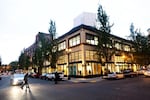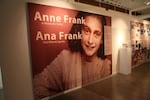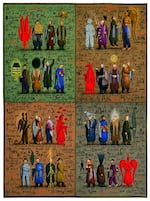
The Oregon Jewish Museum and Center for Holocaust Education's new home on NW Davis Street and 8th Avenue on the Northwest Park Blocks.
Courtesy of OJMCHE
By 2015, the Oregon Jewish Museum and Center for Holocaust Education had a problem — the good kind of problem: It couldn't accommodate the crowds that wanted to get into its exhibits and events. So it commissioned a study to see if it could afford a bigger building. Then director Judy Margles learned that the Museum for Contemporary Craft was closing its downtown Portland doors after 79 years.
“It was just absolutely serendipitous, as we were completing the study in February 2016, this building landed on the market,” Margles said. “We said, 'This building is perfect for us.' It had exactly what we needed: a changing exhibition gallery, space for core exhibitions.”
In its former Kearney location, the Oregon Jewish Museum only had room for one rotating exhibit at a time. So while thousands came to see, say, a blockbuster show on Anne Frank, they weren't able to learn anything about Jewish life in Oregon — and the museum had to go to great lengths to juggle visiting groups of students. Now, the museum has nearly 15,000-square-feet and two floors that includes a 110-seat auditorium for events and screenings, two classrooms, the archives, a café, and a gift shop. The second floor will mostly be taken up by three new core exhibitions focusing on discrimination in Oregon, the Holocaust, and Oregon Jewish life.

"Anne Frank: A History for Today" filled the Oregon Jewish Museum with record crowds in January 2015.
Kelsey Wallace / OPB
And then there's the main gallery, which previously hosted the craft museum's touring shows.
“This is a transformative moment for us and this is certainly a transformative gallery,” Margles said.
The vaulted ceilings are two stories high, with enormous windows looking out over the Northwest Park Blocks.
Margles asked the Portland Art Museum's recently retired chief curator, Bruce Guenther, to curate the first exhibition, and he encouraged them to think ambitiously.
"I proposed that they make a statement with their opening exhibition," Guenther said, "and throughout the course of the year return to the point where they link the exhibition program to a national and international stage, and that by doing so, they would establish this growing and renewed institution both in a national dialogue and as serving the local community."

Grisha Bruskin's "Alefbet: The Alphabet of Memory" includes several large tapestries steeped in Jewish and pop culture iconography.
Courtesy of the Oregon Jewish Museum and Center for Holocaust Education
Guenther will curate three to four exhibits over the first year, beginning with the internationally acclaimed Russian artist Grisha Bruskin’s “Alefbet: Alphabet of Memory,” followed by a show exploring Oregon’s Jewish artists.
“[Alefbet] is five stunning large tapestries that are grounded in Jewish iconography and Jewish rabbinic text,” said Margles, adding that this is the first time the tapestries, which were shown at 2015’s Venice Biennale, will be displayed in America. “And what I love about this exhibit is that it grounds this institution in Jewish content and it's a nod to craft. These tapestries are wool and silk, and I think it's beautiful that our first exhibit is hearkening back to the days that museum of contemporary craft was here.”
Indeed, there was fear in the arts community that the Pacific Northwest College of Art, which took over the Craft Museum in 2009, would sell the facility to the highest bidder, eliminating one of Portland’s few large downtown arts spaces. Instead, it gave the Oregon Jewish Museum a 45-day exclusive to make an offer, and Margles and the rest of the staff are delighted to join the other galleries in the De Soto building at the heart of Portland's gallery district, with plans to participate in the First Thursday gallery walks.
“The Oregon Jewish Museum is an amazing organization,” said Mack McFarland, who was the director of exhibitions in the final months of the craft museum and now runs PNCA’s Center for Contemporary Arts and Culture, which absorbed the craft museum’s collection. “They had a pretty good space where they were, but they were doing so many more projects and working more directly with contemporary artist. I think being able to expand will be lovely for that space.”
The Museum of Contemporary Craft itself had moved into the downtown De Soto building with the goal of entering the national dialogue, and while it succeeded in drawing national accolades for its programming, it was hit hard in the recession and never fully recovered. According to Margles, the Oregon Jewish Museum has learned from the craft museum’s difficulties. Thanks to an outpouring of support, they raised $5 million from 30 donors to buy the space, and they’re more than half way towards raising $2.5 million for an endowment to ensure their sustainability.
The museum will open in June and begin taking part in First Thursdays in July. However, the public can get a sneak peek on Jan. 18 at an event called “Places of Remembrance,” about the gradual series of dehumanizing laws in Germany that led to the Holocaust — a topic Margles sees as still relevant today.
“It opens a door for these other conversations, and that's really our goal today,” she said. “We're not exclusively focused on anti-Semitism; we’re really focused on racist and hate crimes.”
Indeed, the museum has fielded an uptick in requests, mostly from local schools, for educators and its Holocaust speakers bureau in response to an increase in anti-Semitic language and even Holocaust denial over the last year.
“If you had to distill the message that we're trying to get to the youth, it's simply that being a bystander is not okay,” Margles said. “Teaching about the Holocaust, we can give direct examples of how being a bystander led to so much tragedy. So the word is an 'upstander': if you see something that's not okay, you can do something and take action. It's really about helping kids to find courage in what they're doing.”
